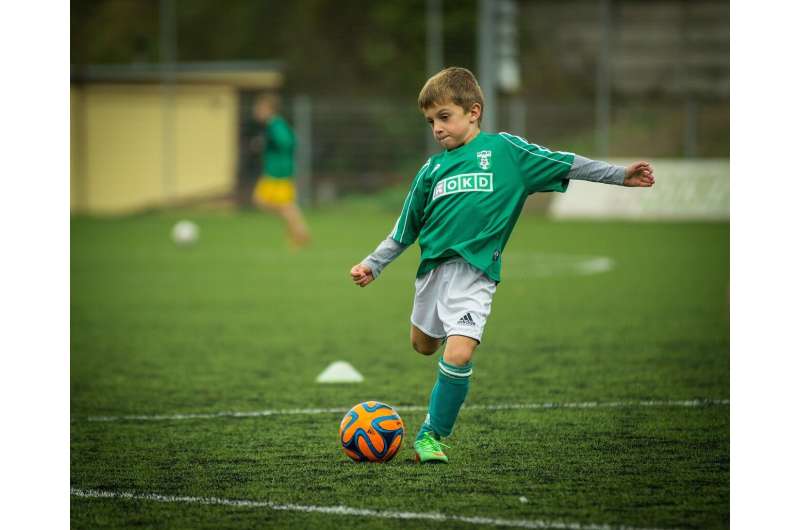Expert alert: Some common youth sports injuries are avoidable

As fall and winter sports are in full swing, youth athletics will see a rise in injuries. Tens of millions of children and teens participate in organized sports, and more than 3.5 million sports injuries occur every year.
Fortunately, most injuries that occur with children are not serious and will not need surgery, according to several Mayo Clinic sports medicine experts. In fact, all of these injuries are avoidable. "Listen to your body," says Anikar Chhabra, M.D., an orthopedic surgeon and the director of Sports Medicine at Mayo Clinic in Arizona. "If patients are hurting and they're having injuries, you have to get early treatment to make sure that this doesn't become a longstanding problem." While the injuries typically vary from gender and age groups, he says the most common sports injuries are:
Shoulder or knee dislocation: An injury to the joint, dislocation occurs when the ends of two bones—connected by the injured joint—are pushed from their positions. Dislocation is common in impact sports.
Growth plate fractures: A more serious condition, prominent in gymnastics and contact sports, that affects the growing tissue layer near the end of a child's bones.
Little League Elbow or Shoulder: This injury, most common in pitchers, is a result of growth plate injuries.
Muscle sprains: Commonly occurring in the ankle, a sprain is the stretching of a ligament that connects two bones together. In more acute cases, the ligament will tear and may require surgery. This condition is found in most sports.
Muscle strains: Strains, or pulled muscles, are a result of an overstretched or torn muscle or tendon, which connects the muscle and bone. Strains can occur during any sport, but its location varies.
Osteochondritis dissecans: A condition of the joint when a lack of blood flow causes the bone underneath the joint's cartilage to die. It is common in runners and jumping-involved sports.
Shin splints (medial tibial stress syndrome): A common condition that causes pain to the shinbone, often due to a changed or intensified workout routine. Shin splints are common in runners and dancers.
Patellar tendinitis (jumper's knee): An injury to the ligament connecting the kneecap to the shinbone that allows for walking, running and jumping movements. It is caused by repeated trauma on the patellar tendon. It is most common in sports involving jumping, such as basketball and volleyball.
Torn ACL: An injury that commonly occurs during soccer, basketball, dancing and more. A torn ACL is the result of sudden changes in direction or stops. ACL tears are more common in high school to college-aged teens and young adults.
Sever's disease in the foot (calcaneal apophysitis): This condition causes heel pain due to stress to the heel's growth plates. It is common in runners.
Chhabra says that these youth sport injuries are on the rise. While some injuries are more serious, the increase is likely a result of kids playing only one sport year-round, instead of playing a different sport each season. The benefit of playing different sports is the child will develop different muscles and train his or her brain to develop different motor skills. Due to the lack of breaks that youths take from their specialized sports, they are at greater risk of injuring themselves. Chhabra says most of his patients' parents admit that their child only takes one or two days off from sports at a time, and he suggests taking two to four weeks off from sports after the season ends to rest.
In addition to avoiding single sport specialization and equipping children with the correct gear, it is important to have proper sport technique and sports movement patterns to help prevent injury and to optimize rehabilitation from an injury, says Edward Laskowski, M.D., co-director of Mayo Clinic Sports Medicine in Minnesota.
"It is not 'practice that makes perfect' but 'perfect practice makes perfect,'" Laskowski says. "If we practice the same bad movement pattern over and over again, a suboptimal motor program is trained into our system and that can raise the risk of injury and decrease sports performance." By analyzing movement, including the use of video, flaws that predispose someone to injury can be detected and corrected, Laskowski says. Once doctors have identified an athlete's risk factor, they can work with the athlete and implement corrective exercises to significantly reduce their risk of getting hurt. In addition, he says the entire sports motion must be evaluated to determine the areas that need improvement. Additionally, proper nutrition and hydration plays an important role in preventive care, says Andrew Jagim, M.D., director of Sports Medicine Research at Mayo Clinic Health System in La Crosse, Wisc. "If an athlete participates in multiple sports at high level without a proper nutrition plan, they may be at risk for slowly breaking their bodies down and leaving them chronically fatigued which can increase their risk of injury."
Jagim also explains that consuming adequate amounts of calories and essential nutrients such as protein, fats and carbohydrates ensures young athletes have the required building blocks to enhance recovery, support training and optimize performance." If your child doesn't get healthy now, he or she will never have that opportunity to play, let alone playing in high school but even in college," Chhabra says. "Young athletes need to get healthy now because these injuries are going to become bigger problems down the road."
©2019 Mayo Foundation for Medical Education and Research
Distributed by Tribune Content Agency, LLC.


















